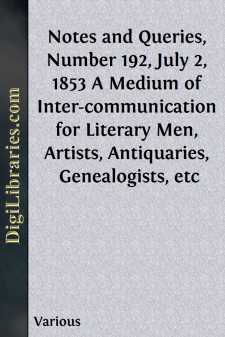Categories
- Antiques & Collectibles 13
- Architecture 36
- Art 48
- Bibles 22
- Biography & Autobiography 813
- Body, Mind & Spirit 142
- Business & Economics 28
- Children's Books 15
- Children's Fiction 12
- Computers 4
- Cooking 94
- Crafts & Hobbies 4
- Drama 346
- Education 46
- Family & Relationships 57
- Fiction 11828
- Games 19
- Gardening 17
- Health & Fitness 34
- History 1377
- House & Home 1
- Humor 147
- Juvenile Fiction 1873
- Juvenile Nonfiction 202
- Language Arts & Disciplines 88
- Law 16
- Literary Collections 686
- Literary Criticism 179
- Mathematics 13
- Medical 41
- Music 40
- Nature 179
- Non-Classifiable 1768
- Performing Arts 7
- Periodicals 1453
- Philosophy 64
- Photography 2
- Poetry 896
- Political Science 203
- Psychology 42
- Reference 154
- Religion 513
- Science 126
- Self-Help 84
- Social Science 81
- Sports & Recreation 34
- Study Aids 3
- Technology & Engineering 59
- Transportation 23
- Travel 463
- True Crime 29
Notes and Queries, Number 192, July 2, 1853 A Medium of Inter-communication for Literary Men, Artists, Antiquaries, Genealogists, etc
by: Various
Categories:
Description:
Excerpt
OBLATION OF A WHITE BULL.
By lease dated 28th April, 1533, the Abbat of St. Edmund's Bury demised to John Wright, glazier, and John Anable, pewterer, of Bury, the manor of Haberdon appurtenant to the office of Sacrist in that monastery, with four acres in the Vynefeld, for twenty years, at the rent of 5l. 4s. to the Sacrist; the tenants also to find a white bull every year of their term, as often as it should happen that any gentlewoman, or any other woman, should, out of devotion, visit the shrine of the glorious king and martyr of St. Edmund, and wish to make the oblation of a white bull. (Dodsw. Coll. in Bibl. Bodl., vol. lxxi. f. 72.)
If we are to understand a white bull of the ancient race of wild white cattle, it may be inferred, I suppose, that in some forest in the vicinity of Bury St. Edmund's they had not disappeared in the first half of the sixteenth century. The wild cattle, probably indigenous to the great Caledonian forest, seem to have become extinct in a wild state before the time of Leland, excepting where preserved in certain ancient parks, as Chillingham Park, Northumberland, Gisburne Park in Craven, &c., where they were, and in the former at all events still are, maintained in their original purity of breed. They were preserved on the lands of some abbeys; for instance, by the Abbats of Whalley, Lancashire.
Whitaker (History of Craven, p. 34.) mentions Gisburne Park as chiefly remarkable for a herd of wild cattle, descendants of that indigenous race which once roamed in the great forests of Lancashire, and they are said by some other writer to have been originally brought to Gisburne from Whalley after the dissolution. One of the descendants of Robert de Brus, the founder of Gainsborough Priory, is stated by Matthew Paris to have conciliated King John with a present of white cattle. The woods of Chillingham Castle are celebrated at this day for the breed of this remarkable race, by which they are inhabited; and I believe there are three or four other places in which they are preserved.
In the form and direction of the horns, these famous wild white oxen seem to be living representatives of the race whose bones are found in a fossil state in England and some parts of the Continent in the "diluvium" bone-caves, mixed with the bones of bears, hyenas, and other wild animals, now the cotemporaries of the Bos Gour, or Asiatic Ox, upon mountainous slopes of Western India. I have read that white cattle resembling the wild cattle of Chillingham exist in Italy, and that it has been doubted whether our British wild cattle are descendants of an aboriginal race, or were imported by ecclesiastics from Italy. But this seems unlikely, because they were not so easily brought over as the Pope's bulls (the pun is quite unavoidable), and were undoubtedly inhabitants of our ancient forests at a very early period.
However, my present object is only to inquire for any other instances of the custom of offering a white bull in honour of a Christian saint. Perhaps some of your correspondents would elucidate this singular oblation....












